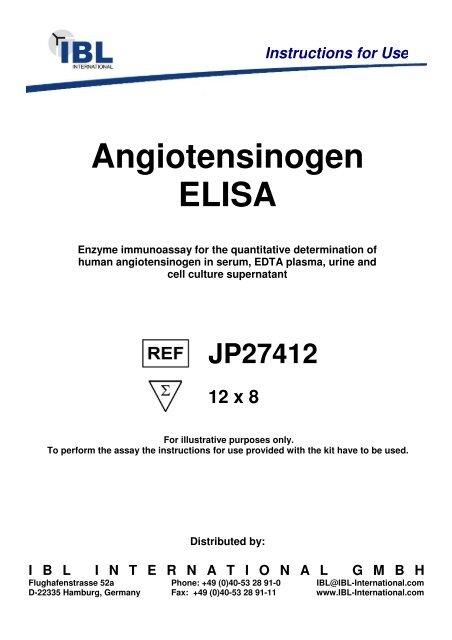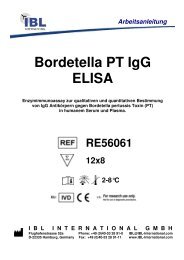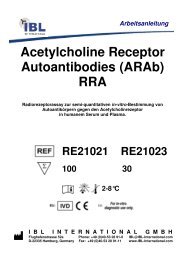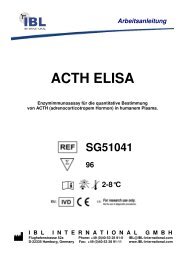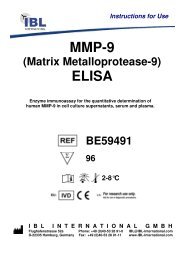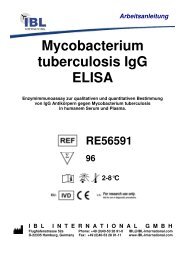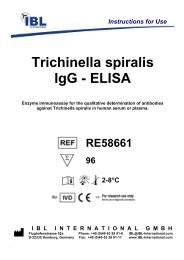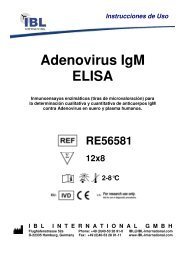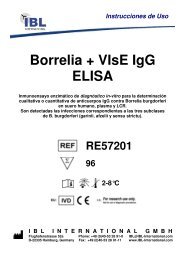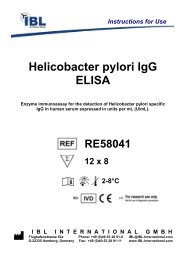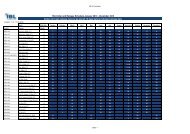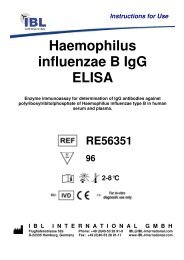Angiotensinogen ELISA - IBL international
Angiotensinogen ELISA - IBL international
Angiotensinogen ELISA - IBL international
Create successful ePaper yourself
Turn your PDF publications into a flip-book with our unique Google optimized e-Paper software.
Instructions for Use<br />
<strong>Angiotensinogen</strong><br />
<strong>ELISA</strong><br />
Enzyme immunoassay for the quantitative determination of<br />
human angiotensinogen in serum, EDTA plasma, urine and<br />
cell culture supernatant<br />
JP27412<br />
12 x 8<br />
For illustrative purposes only.<br />
To perform the assay the instructions for use provided with the kit have to be used.<br />
Distributed by:<br />
I B L I N T E R N A T I O N A L G M B H<br />
Flughafenstrasse 52a Phone: +49 (0)40-53 28 91-0 <strong>IBL</strong>@<strong>IBL</strong>-International.com<br />
D-22335 Hamburg, Germany Fax: +49 (0)40-53 28 91-11 www.<strong>IBL</strong>-International.com
Instructions Code No. 27412 For Non-Clinical Research Use Only p.1<br />
Code No. 27412<br />
Human Total <strong>Angiotensinogen</strong> Assay Kit - <strong>IBL</strong><br />
INTRODUCTION<br />
<strong>Angiotensinogen</strong> is the precursor of angiotensin and is cleaved into angiotensin I<br />
and II in the renin-angiotensin system, and it has long been reported to play an<br />
important role in controlling blood pressure. In recent years interest related to the<br />
role of the renin-angiotensin system in arterial pressure control and the<br />
pathophysiology of hypertension has been shifting to its local role in various tissues.<br />
Among the studies urinary excretion of angiotensinogen in a rat model of<br />
angiotensin II (AII)-dependent hypertension has been reported to be a marker of the<br />
activity of the local intrarenal renin-angiotensin system. Intrarenal AII increases to<br />
an extent in AII-dependent hypertension that cannot be explained by the plasma AII<br />
equilibration alone, and two mechanisms, an increase in intracellular uptake of AII<br />
and an increase in intrarenal expression of angiotensinogen, have been proposed<br />
to explain it.<br />
This product is a complete kit for the quantitative determination of human<br />
angiotensinogen in serum, EDTA-plasma, urine or cell culture media.<br />
PRINCIPLE<br />
This kit is a solid phase sandwich <strong>ELISA</strong> using 2 kinds of high specific antibodies.<br />
Tetra Methyl Benzidine (TMB) is used as a coloring agent (Chromogen). The<br />
strength of coloring is proportional to the quantities of Human <strong>Angiotensinogen</strong>.<br />
MEASUREMENT RANGE<br />
0.31 ~ 20 ng/mL<br />
(6.0 – 384.6 pmol/L, as molecular weight of Human <strong>Angiotensinogen</strong> is 52 kDa)<br />
INTENDED USE<br />
■ This kit can measure Human <strong>Angiotensinogen</strong> in serum, EDTA-plasma, urine<br />
or cell culture media. And dilute test samples with special “4, EIA buffer” as<br />
necessary before assay.<br />
■ The recommended dilution for urine samples is about 4 - 8 fold.<br />
■ The recommended dilution for serum or EDTA-plasma samples is about 10,000<br />
fold.<br />
■ The recommended dilution for cell culture media samples is various by using<br />
cells, therefore, the dilution rate should be optimized by each laboratories.<br />
KIT COMPONENT<br />
1 Precoated plate : Anti-Human AGT (72) Rabbit IgG Affinity Purify 96Well x 1<br />
2 Labeled antibody Conc.<br />
: (30X) HRP conjugated Anti- Human AGT (601) Mouse IgG Fab’ Affinity Purify 0.4mL x 1<br />
3 Standard : <strong>Angiotensinogen</strong> from human plasma 0.5mL x 2<br />
4 EIA buffer 30mL x 1<br />
5 Solution for Labeled antibody : 1% BSA, 0.05% Tween20 in PBS 12mL x 1<br />
6 Chromogen : TMB solution 15mL x 1<br />
7 Stop solution : 1N H 2 SO 4 12mL x 1<br />
8 Wash buffer Conc. : (40X) 0.05% Tween20 in phosphate buffer 50mL x 1<br />
OPERATION MANUAL<br />
1. Materials needed but not supplied<br />
・Plate reader (450nm)<br />
・Micropipette and tip<br />
・Graduated cylinder and beaker ・Deionized water<br />
・Incubator (37°C ± 1°C) ・Graph paper (log/log)<br />
・Paper towel<br />
・Tube for dilution of Standard<br />
・Washing bottle for precoated plate<br />
・Disposable test tube for “2, Labeled antibody Conc.” and “6, Chromogen”<br />
2. Preparation<br />
1) Preparation of wash buffer<br />
“8, Wash buffer Conc.” is a concentrated (40X) buffer. Adjust the<br />
temperature of “8, Washing buffer Conc.” to room temperature and then, mix<br />
it gently and completely before use. Dilute 50 mL of “8, Wash buffer Conc.”<br />
with 1,950 mL of deionized water and mix it. This is the wash buffer for use.<br />
This prepared wash buffer shall be stored in refrigerator and used within 2<br />
weeks after dilution.<br />
2) Preparation of Labeled antibody<br />
“2, Labeled antibody Conc.” is a concentrated (30X). Dilute “2, Labeled<br />
antibody Conc.” with “5, Solution for Labeled antibody” in 30 times according<br />
to required quantity into a disposable test tube. Use this resulting solution as<br />
Labeled antibody.<br />
Example)<br />
In case you use one strip (8 well), the required quantity of Labeled antibody<br />
is 800 μL. (Dilute 30 μL of “2, Labeled antibody Conc.” with 870 μL of “5,<br />
Solution for Labeled antibody” and mix it. And use the resulting solution by<br />
100 μL in each well.)<br />
This operation should be done just before the application of Labeled<br />
antibody.<br />
The remaining “2, Labeled antibody Conc.” should be stored at 4℃ in firmly<br />
sealed vial.<br />
3) Preparation of Standard<br />
Put just 0.5 mL of deionized water into the vial of “3, Standard” and mix it<br />
gently and completely. This solution is 40 ng/mL (769.2 pmol/L) Human<br />
<strong>Angiotensinogen</strong> standard.<br />
4) Dilution of Standard<br />
Prepare 8 tubes for dilution of “3, Standard”. Put 230 μL each of “4, EIA<br />
buffer” into the tube.<br />
Specify the following concentration of each tube.”<br />
Tube-1<br />
20 ng/mL (384.6 pmol/L)<br />
Tube-2<br />
10 ng/mL (192.3 pmol/L)<br />
Tube-3 5 ng/mL (96.2 pmol/L)<br />
Tube-4 2.5 ng/mL (48.1 pmol/L)<br />
Tube-5 1.25 ng/mL (24.0 pmol/L)<br />
Tube-6 0.63 ng/mL (12.1 pmol/L)<br />
Tube-7 0.31 ng/mL (6.0 pmol/L)<br />
Tube-8<br />
0 ng/mL (0 pmol/L) (Test Sample Blank)<br />
Put 230 μL of Standard solution into tube-1 and mix it gently. Then, put 230 μL<br />
of tube-1 mixture into tube-2. Dilute two times standard solution in series to set<br />
up 7 points of diluted standard between 20 ng/mL (384.6 pmol/L) and 0.31<br />
ng/mL (6.0 pmol/L). Tube-8 is the test sample blank as 0 ng/mL (0 pmol/L).<br />
See following picture.<br />
230 μL standard solution<br />
“4, EIA buffer”<br />
230 μL<br />
1 2 3 4 5 6 7 8<br />
Conc. (ng/mL) 20 10 5 2.5 1.25 0.63 0.31 0<br />
(pmol/L) 384.6 192.3 96.2 48.1 24.0 12.1 6.0 0<br />
5) Dilution of test sample<br />
Test sample may be diluted with special “4, EIA buffer” as necessary.<br />
If the concentration of Human <strong>Angiotensinogen</strong> in samples may not be<br />
estimated in advance, the pre-assay with several different dilutions will be<br />
recommended to determine the proper dilution of samples.<br />
When “4, EIA buffer” in kit is not enough for dilution, customers can purchase<br />
additional kit component (30 mL, Code No. 27412D) or large volume EIA buffer<br />
for Human <strong>Angiotensinogen</strong> (100 mL, Code No. 27412D100).<br />
6) Example of sample dilution<br />
x 10,000 dilution of serum or EDTA-plasma<br />
At first, add 990 μL of “4, EIA buffer” to 10 μL of sample and mix it gently and<br />
completely. Then, this solution is “100 fold diluted sample”.<br />
Next, add 990 μL of “4, EIA buffer” to 10 μL of the “100 fold diluted sample” and<br />
mix it again. Then, this resulting solution is 10,000 fold diluted sample and use it<br />
for determination.<br />
3. Measurement procedure<br />
All reagents shall be brought to room temperature approximately 30 minutes<br />
before use. Then mix it gently and completely before use. Make sure of no<br />
change in quality of the reagents. Standard curve shall be prepared<br />
simultaneously with the measurement of test samples.<br />
Reagents<br />
Labeled<br />
Antibody<br />
Test Sample<br />
Test sample<br />
100 μL<br />
Standard<br />
Diluted<br />
standard<br />
(Tube 1-7)<br />
100 μL<br />
Test Sample<br />
Blank<br />
EIA buffer<br />
(Tube-8)<br />
100 μL<br />
Incubation for 60 minutes at 37°C with plate lid<br />
Washing 7 times<br />
Reagent<br />
Blank<br />
EIA buffer<br />
100 μL<br />
100 μL 100 μL 100 μL -<br />
Incubation for 30 minutes at 37°C with plate lid<br />
Washing 9 times<br />
Chromogen 100 μL 100 μL 100 μL 100 μL<br />
Incubation for 30 minutes at room temperature (shielded)<br />
Stop solution 100 μL 100 μL 100 μL 100 μL<br />
Read the plate at 450nm against a Reagent Blank<br />
within 30 minutes after addition of Stop solution.<br />
1) Determine wells for reagent blank. Put 100 μL each of “4, EIA buffer” into the<br />
wells.<br />
2) Determine wells for test sample blank, test sample and diluted standard.<br />
Then, put 100 μL each of test sample blank (tube-8), test sample and<br />
dilutions of standard (tube-1-7) into the appropriate wells.<br />
3) Incubate the precoated plate for 60 minutes at 37°C after covering it with<br />
plate lid.<br />
4) Wash each well of the precoated plate vigorously with wash buffer using the<br />
washing bottle. Then, fill each well with wash buffer and leave the precoated<br />
plate laid for 15-30 seconds. Remove wash buffer completely from the<br />
precoated plate by snapping. This procedure must be repeated more than 7<br />
times. Then, remove the remaining liquid from all wells completely by<br />
snapping the precoated plate onto paper towel.<br />
In case of using a plate washer, after 4 times washing with plate washer,<br />
washing with above washing bottle must be repeated 3 times.<br />
5) Pipette 100 μL of labeled antibody solution into the wells of test samples,<br />
diluted standard and test sample blank.<br />
6) Incubate the precoated plate for 30 minutes at 37°C after covering it with<br />
plate lid.<br />
7) Wash the precoated plate 9 times in the same manner as 4).<br />
8) Take the required quantity of “6, Chromogen” into a disposable test tube.<br />
Then, pipette 100 μL from the test tube into the wells. Please do not return<br />
the rest of the test tube to “6, Chromogen” bottle to avoid contamination.<br />
9) Incubate the precoated plate for 30 minutes at room temperature in the dark.<br />
The liquid will turn blue by addition of “6, Chromogen”.<br />
10) Pipette 100 μL of “7, Stop solution” into the wells. Mix the liquid by tapping the<br />
side of precoated plate. The liquid will turn yellow by addition of “7, Stop<br />
solution”.<br />
11) Remove any dirt or drop of water on the bottom of the precoated plate and<br />
confirm there is no bubble on the surface of the liquid. Then, run the plate<br />
reader and conduct measurement at 450 nm against a reagent blank.<br />
The measurement shall be done within 30 minutes after addition of “7, Stop<br />
solution”.<br />
Immuno-Biological Laboratories Co., Ltd.<br />
5-1 Aramachi, Takasaki-Shi, Gunma, 370-0831, JAPAN<br />
TEL: +81 (0)27-310-8040 FAX : +81 (0)27-310-8045 URL: http://www.ibl-japan.co.jp E-mail: do-ibl@ibl-japan.co.jp
Instructions Code No. 27412 For Non-Clinical Research Use Only p.2<br />
SPECIAL ATTENTION<br />
1) Test samples should be measured soon after collection. For the storage of<br />
test samples, store them frozen and do not repeat freeze/thaw cycles. Thaw<br />
the test samples at a low temperature and mix them completely before<br />
measurement.<br />
2) Test samples should be diluted with “4, EIA buffer”, if the need arises.<br />
3) Duplicate measurement of test samples and standard is recommended.<br />
4) Use test samples in neutral pH range. The contaminations of organic solvent<br />
may affect the measurement.<br />
5) Use only wash buffer contained in this kit for washing the precoated plate.<br />
Insufficient washing may lead to the failure in measurement.<br />
6) Remove the wash buffer completely by tapping the precoated plate on paper<br />
towel. Do not wipe wells with paper towel.<br />
7) “6, Chromogen” should be stored in the dark due to its sensitivity against light.<br />
“6, Chromogen” should be avoided contact with metals.<br />
8) Measurement should be done within 30 minutes after addition of “7, Stop<br />
solution”.<br />
CALCULATION OF TEST RESULT<br />
Subtract the absorbance of test sample blank from all data, including standards and<br />
unknown samples before plotting. Plot the subtracted absorbance of the standards<br />
against the standard concentration on log-log graph paper. Draw the best smooth<br />
curve through these points to construct the standard curve. Read the<br />
concentration for unknown samples from the standard curve.<br />
Example of standard curve<br />
Conc.<br />
ng/mL (pmol/L)<br />
OD 450<br />
10<br />
1<br />
0.1<br />
0.01<br />
0.1 1 10 100<br />
Human angiotensinogen (ng/mL)<br />
* The typical standard curve is shown above. This curve can not be used to<br />
derive test results. Please run a standard curve for each assay.<br />
PERFORMANCE CHARACTERISTICS<br />
1. Titer Assay (Samples with standard added are used.)<br />
Specimen<br />
10% FCS<br />
added<br />
RPMI-1640<br />
Human<br />
Serum<br />
Human<br />
Plasma<br />
(EDTA)<br />
Human Urine<br />
2. Added Recovery Assay<br />
Specimen<br />
10% FCS added<br />
RPMI-1640 (x2)<br />
Human<br />
Serum<br />
(x8,000)<br />
Human<br />
Plasma (EDTA)<br />
(x8,000)<br />
Human Urine<br />
(x8)<br />
Absorbance<br />
(450nm)<br />
20 (384.6) 3.221<br />
10 (192.3) 1.604<br />
5 (96.2) 0.856<br />
2.5 (48.1) 0.426<br />
1.25 (24.0) 0.216<br />
0.63 (12.1) 0.108<br />
0.31 (6.0) 0.058<br />
0 (Test Sample<br />
0.003<br />
Blank)<br />
Titer<br />
(X)<br />
Measurement<br />
Value (ng/mL)<br />
Theoretical<br />
Value (ng/mL)<br />
2 4.57 5.00 91.4<br />
4 2.34 2.50 93.6<br />
8 1.21 1.25 96.8<br />
8,000 5.44 5.54 98.2<br />
16,000 2.69 2.86 94.1<br />
32,000 1.38 1.52 90.8<br />
8,000 5.94 6.26 94.9<br />
16,000 3.17 3.18 99.7<br />
32,000 1.54 1.59 96.9<br />
8 2.67 2.70 98.9<br />
16 1.31 1.36 96.3<br />
32 0.64 0.64 100.0<br />
Theoretical<br />
Value (ng/mL)<br />
Measurement<br />
Value (ng/mL)<br />
%<br />
5.00 4.24 84.8<br />
2.50 2.17 86.8<br />
1.25 1.07 85.6<br />
9.39 8.03 85.5<br />
6.89 6.03 87.5<br />
5.64 5.07 89.9<br />
9.29 7.70 82.9<br />
6.79 6.50 95.7<br />
5.54 4.98 89.9<br />
7.47 6.54 87.6<br />
4.97 4.69 94.4<br />
3.72 3.38 90.9<br />
%<br />
3. Intra - Assay<br />
Measurement<br />
Value (ng/mL)<br />
SD value CV value (%) n<br />
8.81 0.39 4.4 24<br />
2.14 0.11 5.1 24<br />
0.73 0.04 5.5 24<br />
4. Inter - Assay<br />
5. Specificity<br />
Measurement<br />
Value (ng/mL)<br />
SD value CV value (%) n<br />
8.77 0.38 4.3 32<br />
2.14 0.10 4.7 32<br />
0.71 0.05 7.0 32<br />
Compound<br />
Cross Reactivity<br />
Human <strong>Angiotensinogen</strong> 100 %<br />
Angiotensin I ≦0.1 %<br />
Angiotensin II ≦0.1 %<br />
Angiotensin III ≦0.1 %<br />
Angiotensin IV ≦0.1 %<br />
Angiotensin (1-7) ≦0.1 %<br />
Angiotensin (1-9) ≦0.1 %<br />
Human albumin ≦0.1 %<br />
Human IgG ≦0.1 %<br />
Human Angiopoietin-like 3 ≦0.1 %<br />
6. Sensitivity<br />
0.03 ng/mL<br />
The sensitivity for this kit was determined using the guidelines under the<br />
National Committee for Clinical Laboratory Standards (NCCLS) Evaluation<br />
Protocols. (National Committee for Clinical Laboratory Standards Evaluation<br />
Protocols, SC1, (1989) Villanova, PA: NCCLS.)<br />
PRECAUTION FOR INTENDED USE AND/OR HANDLING<br />
1. All reagents should be stored at 2 - 8°C. All reagents shall be brought to room<br />
temperature approximately 30 minutes before use.<br />
2. “3, Standard” is lyophilized products. Be careful to open this vial.<br />
3. “7, Stop solution” is a strong acid substance. Therefore, be careful not to have<br />
your skin and clothes contact “7, Stop solution” and pay attention to the<br />
disposal of “7, Stop solution”.<br />
4. “1, Precoated plate” and “3, Standard” contain sodium azide. Therefore,<br />
dispose these materials after diluting them with large quantity of water to avoid<br />
production of explosive metallic azide.<br />
5. Precipitation may occur in “2, Labeled antibody Conc.”, however, there is no<br />
problem in the performance.<br />
6. Wash hands after handling reagents.<br />
7. Do not mix the reagents with the reagents from a different lot or kit.<br />
8. Do not use expired reagents.<br />
9. This kit is for research purpose only. Do not use for clinical diagnosis.<br />
STORAGE AND THE TERM OF VALIDITY<br />
Storage Condition : 2 - 8°C<br />
The term of validity : 12 months<br />
(The expiry date is specified on outer box.)<br />
REFERENCE<br />
1. Kobori H, Harrison-Bernard LM, Navar LG. Expression of angiotensinogen<br />
mRNA and protein in angiotensin II-dependent hypertension. J Am Soc Nephrol.<br />
2001 Mar;12(3):431-9.<br />
2. Kobori H, Harrison-Bernard LM, Navar LG. Enhancement of angiotensinogen<br />
expression in angiotensin II-dependent hypertension. Hypertension. 2001<br />
May;37(5):1329-35.<br />
3. Kobori H, Harrison-Bernard LM, Navar LG. Urinary excretion of<br />
angiotensinogen reflects intrarenal angiotensinogen production. Kidney Int.<br />
2002 Feb;61(2):579-85.<br />
4. Kobori H, Nishiyama A, Harrison-Bernard LM, Navar LG. Urinary<br />
angiotensinogen as an indicator of intrarenal Angiotensin status in hypertension.<br />
Hypertension. 2003 Jan;41(1):42-9.<br />
5. Kobori H, Prieto-Carrasquero MC, Ozawa Y, Navar LG. AT1 receptor<br />
mediated augmentation of intrarenal angiotensinogen in angiotensin<br />
II-dependent hypertension. Hypertension. 2004 May;43(5):1126-32.<br />
6. Katsurada A, Hagiwara Y, Miyashita K, Satou R, Miyata K, Ohashi N, Navar LG,<br />
Kobori H. Novel sandwich <strong>ELISA</strong> for human angiotensinogen.Am J Physiol<br />
Renal Physiol. 2007 Sep;293(3):F956-60.<br />
7. Kobori H, Nangaku M, Navar LG, Nishiyama A. The intrarenal<br />
renin-angiotensin system: from physiology to the pathobiology of hypertension<br />
and kidney disease.Pharmacol Rev. 2007 Sep;59(3):251-87.<br />
Version 1.<br />
Immuno-Biological Laboratories Co., Ltd.<br />
5-1 Aramachi, Takasaki-Shi, Gunma, 370-0831, JAPAN<br />
TEL: +81 (0)27-310-8040 FAX : +81 (0)27-310-8045 URL: http://www.ibl-japan.co.jp E-mail: do-ibl@ibl-japan.co.jp
Symbols / Symbole / Symbôles / Símbolos / Símbolos / Σύµβολα<br />
REF<br />
LOT<br />
Cat.-No.: / Kat.-Nr.: / No.- Cat.: / Cat.-No.: / N.º Cat.: / N.–Cat.: / Αριθµός-Κατ.:<br />
Lot-No.: / Chargen-Bez.: / No. Lot: / Lot-No.: / Lote N.º: / Lotto n.: / Αριθµός -Παραγωγή:<br />
Use by: / Verwendbar bis: / Utiliser à: / Usado por: / Usar até: / Da utilizzare entro: /<br />
Χρησιµοποιείται από:<br />
No. of Tests: / Kitgröße: / Nb. de Tests: / No. de Determ.: / N.º de Testes: / Quantità dei tests: /<br />
Αριθµός εξετάσεων:<br />
CONC Concentrate / Konzentrat / Concentré / Concentrar / Concentrado / Concentrato / Συµπύκνωµα<br />
LYO<br />
IVD<br />
Lyophilized / Lyophilisat / Lyophilisé / Liofilizado / Liofilizado / Liofilizzato / Λυοφιλιασµένο<br />
In Vitro Diagnostic Medical Device. / In-vitro-Diagnostikum. / Appareil Médical pour Diagnostics In<br />
Vitro. / Dispositivo Médico para Diagnóstico In Vitro. / Equipamento Médico de Diagnóstico In<br />
Vitro. / Dispositivo Medico Diagnostico In vitro. / Ιατρική συσκευή για In-Vitro ∆ιάγνωση.<br />
Evaluation kit. / Nur für Leistungsbewertungszwecke. / Kit pour évaluation. / Juego de Reactivos<br />
para Evaluació. / Kit de avaliação. / Kit di evaluazione. / Κιτ Αξιολόγησης.<br />
Read instructions before use. / Arbeitsanleitung lesen. / Lire la fiche technique avant emploi. /<br />
Lea las instrucciones antes de usar. / Ler as instruções antes de usar. / Leggere le istruzioni<br />
prima dell’uso. / ∆ιαβάστε τις οδηγίες πριν την χρήση.<br />
Keep away from heat or direct sun light. / Vor Hitze und direkter Sonneneinstrahlung schützen. /<br />
Garder à l’abri de la chaleur et de toute exposition lumineuse. / Manténgase alejado del calor o la<br />
luz solar directa. / Manter longe do calor ou luz solar directa. / Non esporre ai raggi solari. / Να<br />
φυλάσσεται µακριά από θερµότητα και άµεση επαφή µε το φως του ηλίου.<br />
Store at: / Lagern bei: / Stocker à: / Almacene a: / Armazenar a: / Conservare a: / Αποθήκευση<br />
στους:<br />
Manufacturer: / Hersteller: / Fabricant: / Productor: / Fabricante: / Fabbricante: / Παραγωγός:<br />
Caution! / Vorsicht! / Attention! / ¡Precaución! / Cuidado! / Attenzione! / Προσοχή!<br />
Symbols of the kit components see MATERIALS SUPPLIED.<br />
Die Symbole der Komponenten sind im Kapitel KOMPONENTEN DES KITS beschrieben.<br />
Voir MATERIEL FOURNI pour les symbôles des composants du kit.<br />
Símbolos de los componentes del juego de reactivos, vea MATERIALES SUMINISTRADOS.<br />
Para símbolos dos componentes do kit ver MATERIAIS FORNECIDOS.<br />
Per i simboli dei componenti del kit si veda COMPONENTI DEL KIT.<br />
Για τα σύµβολα των συστατικών του κιτ συµβουλευτείτε το ΠΑΡΕΧΟΜΕΝΑ ΥΛΙΚΑ.<br />
<strong>IBL</strong> AFFILIATES WORLDWIDE<br />
<strong>IBL</strong> International GmbH<br />
Flughafenstr. 52A, 22335 Hamburg, Germany<br />
<strong>IBL</strong> International B.V.<br />
Zutphenseweg 55, 7418 AH Deventer, The Netherlands<br />
<strong>IBL</strong> International Corp.<br />
194 Wildcat Road, Toronto, Ontario M3J 2N5, Canada<br />
Tel.: + 49 (0) 40 532891 -0 Fax: -11<br />
E-MAIL: <strong>IBL</strong>@<strong>IBL</strong>-International.com<br />
WEB: http://www.<strong>IBL</strong>-International.com<br />
Tel.: + 49 (0) 40 532891 -0 Fax: -11<br />
E-MAIL: <strong>IBL</strong>@<strong>IBL</strong>-International.com<br />
WEB: http://www.<strong>IBL</strong>-International.com<br />
Tel.: +1 (416) 645 -1703 Fax: -1704<br />
E-MAIL: Sales@<strong>IBL</strong>-International.com<br />
WEB: http://www.<strong>IBL</strong>-International.com<br />
LIABILITY: Complaints will be accepted in each mode –written or vocal. Preferred is that the complaint is accompanied with the test performance<br />
and results. Any modification of the test procedure or exchange or mixing of components of different lots could negatively affect the results. These<br />
cases invalidate any claim for replacement. Regardless, in the event of any claim, the manufacturer’s liability is not to exceed the value of the test kit.<br />
Any damage caused to the kit during transportation is not subject to the liability of the manufacturer.<br />
Symbols Version 3.5 / 2011-07-01


